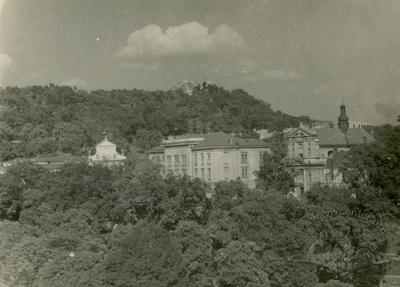Vul. Kryvonosa, 01 – St. Clement Sheptytskyi Church
The complex of the Reformats monastery with the St. Casimir (St. Clement Sheptytsky) church and the hospital of the sisters of charity with the St. Vincent chapel (the academic building of the Lviv State University of Internal Affairs) belong to early examples of Baroque style in Lviv. According to the resolution of the Council of Ministers of the Ukrainian SSR number 442 dated 6 September 1979, the church was entered into the National register of monuments under protection number 1327; according to the resolution of the Regional Executive Committee of the Lviv Region number 130 dated 26 February 1980, the hospital complex was entered into the Register of local monuments under protection number 139-M.
Architecture
St. Casimir church is a one-nave building with a rectangular apse. It is built of brick and hewn stone, its façades are plastered. Its character is rather modest: the church's side façades have no architectural decor, only the principal one has Baroque style features. It is terminated by a pediment with stone vases with statues of saints in its tympanum. Over the chancel the roof's crest is crowned with a Baroque-styled flèche. As old photos show, a babynets (narthex, a room for women) topped with a pediment of the same style, was once attached to the main entrance.
Generally, the church's layout is typical for the Reformats' order churches. In particular, this can be seen quite clearly from the interior. The nave is three bays long. By the entrance, a choir gallery is situated. Each bay is articulated by recessions in the exterior walls, which are formed by wide pillars supporting semicircular arches. These pillars also support the cross vaults and are decorated with pilasters.
A similar architecture can be seen in the Reformat fathers’ St. Michael church in Rava-Ruska, Lviv region.
Generally, st. Casimir church in Lviv is a valuable monument of the early Baroque architecture in Ukraine.
Personalities
Adam Opolski – an architect.
Alfred Kamienobrodzki – a Lviv architect.
Bartołomeusz
Zimorowicz – a Lviv chronicler who wrote a book entitled Leopolis triplex.
Bohdan Zynoviy
Khmelnytsky – a hetman of Zaporozhian cossacks who led the Liberation War of the
Ukrainian people (1648-1654).
Bonaventura – a monk, one of the
first priors of the Lviv Reformats monastery
Wincenty Rawski (1810-1876) – a Lviv
architect.
Jan Daniłowicz (Ivan Danylovych,
1570-1628) – a Ruthenian voivode.
Ignacy Kędzierski – an architect and
urbanist.
Josef Fromm – a Lviv architect.
Kajetan Semenczak – a Lviv constructor.
Edmund Köhler – a Lviv constructor.
Clement Casimir
Sheptytsky – a Studite monks’ archimandrite beatified by the Catholic Church.
Martin Krzywoszyński – a Lviv constructor.
Mikołaj
Biganowski – a castellan of Kamyanets, the founder of the masonry St. Casimir
church.
Zofia Daniłowicz (Żółkiewska) –the wife of Jan Daniłowicz, a Ruthenian
voivode.
Stanisław
Mniszek – a starosta (royal official)
of Lviv.
Jan Andrzej Pruchnicki – a
Roman Catholic archbishop of Lviv in 1614-1633.
Sources
1. State Archive of Lviv
Oblast (DALO). Item 2/1/6393
2. DALO. Item 2/1/5659
3. Central State Historical Archive of Ukraine in Lviv (CDIAL). Item 146/84/2146
4. CDIAL. Item 146/84/49
5. CDIAL. Item 146/84/50
6. Chodynicki, Historya stołecznego królestw Galicyi і Lodomeryi miasta Lwowa od założenia jego aż do czasów
teraznieyszych (Lwów, 1829).
7. Zygmunt Gloger, Encyklopedja staropolska, T. III (Warszawa, 1974).
8. Бартоломей
Зиморович, Потрійний Львів (Львів, 2002), 169.
9. Володимир
Вуйцик, Костел Св. Казимира у Львові, Вісник інституту
Укрзахідпроектреставрація, 2004, Ч. 14, 95-96.
10. Денис
Зубрицький, Хроніка міста Львова (Львів, 2002).
Media Archive Materials
Related Pictures


















